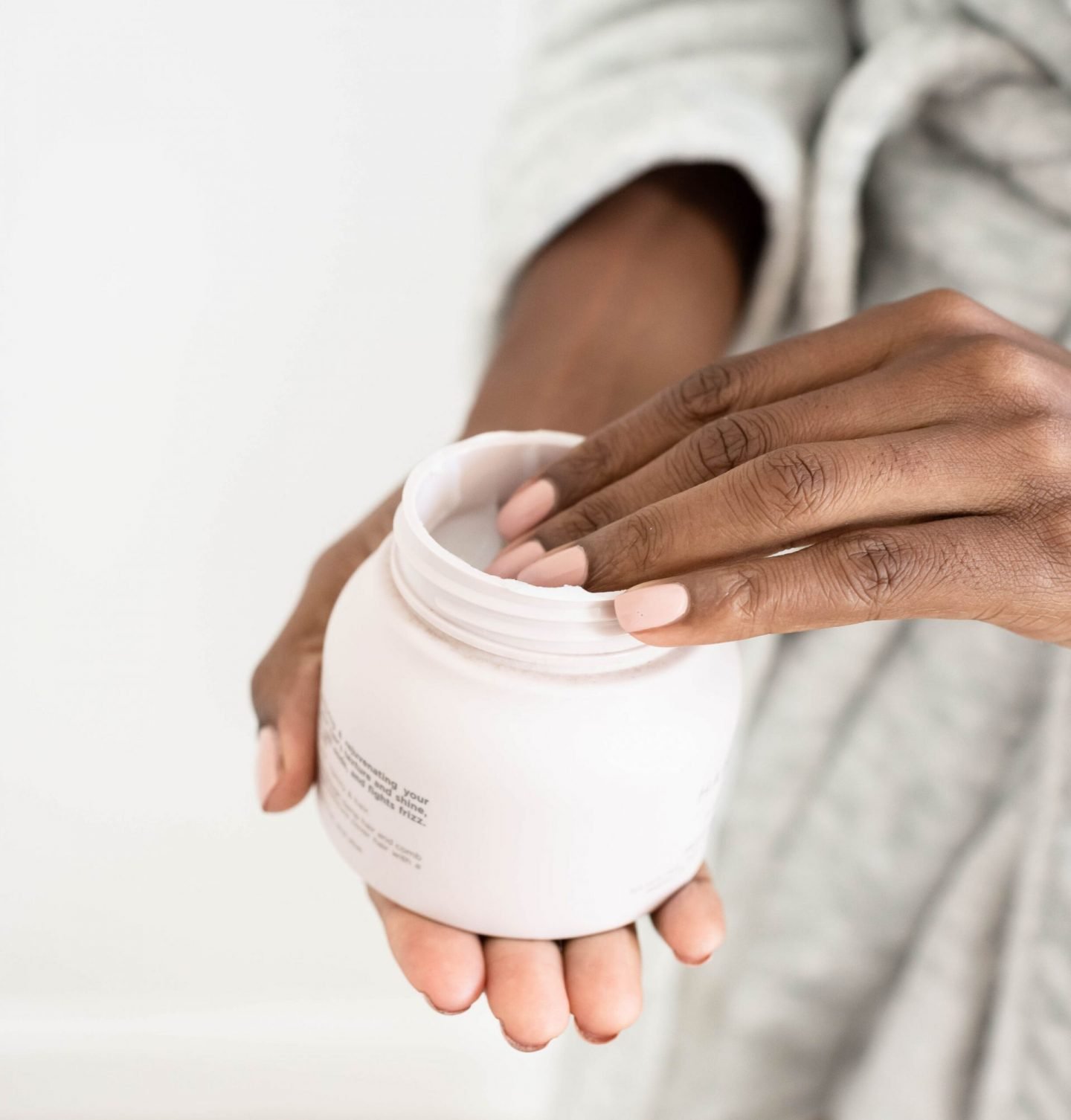
Dry skin can happen all year round due to changing temperatures and weather conditions. But, it can be especially during winter due to more time being spent indoors with the central heating on, zapping the natural moisture in the air.
If you’re a fellow dry skin sufferer, you’ll know how frustrating it can be trying to stop the flakes from taking over your face. You might feel self-conscious every time you look in the mirror or spend hundreds of pounds trying every dry skin product in sight.
That said, if you truly want to figure out how to eliminate dry skin, first you need to understand why it might be happening. That’s why I’ve enlisted the help of an expert to break the topic down for us.

Why Is Your Skin Dry?
Let’s start with the basics. The skin is made up of three layers: the outer layer (the epidermis), the underlying skin (the dermis) and the subcutaneous tissue. Essentially, if the outermost layer of the epidermis doesn’t contain enough water, your skin will lose elasticity, look dry and feel rough.
Age plays an important role in this problem. According to Dr. Mark J. Hudson-Peacock, Consultant Dermatologist at Stratum Clinics, there are several reasons why our skin gets drier as we get older. T
To put it simply, the skin starts to thin out as natural oil production reduces in the body. “The concentration of natural moisturising factors (NMFs) in the skin, such as urea, decreases as we age,” he says. “As a result, the skin becomes less resilient to what the environment throws it.”
The lower legs are prone to these effects since the skin is already thinner in this area and experiences a reduced production of natural oils. Dr. Hudson-Peacock explains: “The sebaceous glands are larger and most numerous on the face and upper body, getting less productive the further peripherally you go down the arms and legs, in particular.”
If you’re struggling with dry skin elsewhere on your body as well as on your face, the good news is, this is a common issue that can be remedied.
How to Eliminate Dry Skin Internally
Follow these steps to remedy dry skin from the inside out.
Drink Lots of Water
Firstly, because your skin functions as a protective barrier to prevent excess fluid loss, dehydration can make your skin look more dry and wrinkled. drinking plenty of water can have a positive effect on your skin, as well as your health in general.
Aim to drink eight 8-ounce glasses a day (about half a gallon of water), according to Healthline. Also known as the 8×8 method, it can rehydrate your whole body and kick dry skin to the curb.
Eat a Healthy Diet
Alongside water, vitamins can help the skin to stay hydrated if they’re consumed as part of a healthy, balanced diet. In fact, the body can absorb what it needs and expel what it doesn’t.
Dr. Hudson-Peacock says that vitamins A, B, C, D and E are all known to be vital to good health — and good skin health specifically. These vitamins can be found in the following foods:
- A – eggs, dark, leafy vegetables, orange and yellow fruits and veggies
- B – whole grains, meat, seeds and nuts
- C – broccoli, potatoes, citrus fruit
- D – oily fish, red meat, egg yolks
- E – almonds, pumpkin, red bell pepper
So, get munching!
Consider Supplementation
In the case of dietary deficiencies or poor absorption, supplementing with vitamins A, B, C, D and E can significantly improve skin hydration. This can then aid the body in its various functions of growth and repair, including the skin.
As someone prone to dry skin, I’ve been pleasantly surprised by taking fish oil capsules* every day. Omega-3s are effective in softening rough, dry skin and soothing irritation. Although, it is possible to get your fix of omega-3s naturally by eating oily fish like mackerel and herring.
How to Eliminate Dry Skin Externally
To maintain well-hydrated skin from the outside in, Dr. Hudson-Peacock has some key recommendations.
Wash Mindfully
How you wash your skin can make all the difference in the world! Follow these tips so you no longer have to wonder how to eliminate dry skin:
- Avoid prolonged contact with overly hot or cold water, especially if it contains detergents (use cotton-lined gloves for washing dishes, for instance).
- Consider using a water softener if you live in a hard water area.
- Pat the skin dry after washing rather than vigorously towelling off.
I recently started washing my face with cold water and noticed a huge difference in the flakiness of my skin. (The snake-like scales aren’t as intense as they were before. Victory!)

Use a Humidifier
Given that a humidifier can put the moisture back into the air, it’s a worthwhile investment for someone who struggles with dry skin. Dr. Hudson-Peacock says, “This is especially the case during the winter months when the air is drier and the skin is more prone to dehydration.”
And if you’re a light sleeper? Not to worry — you can opt for a silent version that won’t interfere with you getting some serious shut-eye.
Choose the Right Products
Always be mindful of what you’re putting on dry skin. For example:
- Use a gentle fragrance-free cleanser on your face, avoiding ordinary soaps that remove the natural oils from your skin.
- “Lock” moisture into the skin using a heavy-duty moisturiser that will create a physical barrier.
- Moisturise immediately after washing your face to seal in the moisture as fast as possible.
- Use a hydration face mask once a week to give your skin a much-needed glow.
Oh, and keep in mind that there is evidence to suggest that applying vitamins to the skin is more likely to get results compared to consuming them.
Products and Ingredients That Can Ease Dry Skin
Wondering how to eliminate dry skin with products alone? Dr. Hudson-Peacock explains: “Some people prefer creams or lotions, others prefer oils and ointments. Generally speaking, the oilier or greasier the product, the better it is at keeping the skin hydrated but many people don’t like the greasiness.”
He continues: “To make a moisturiser more creamy and acceptable, while simultaneously maintaining its hydrating effect, various ingredients can be added.”
Nicotinamide, glycerol, urea, ceramides and fatty acids are examples of some of the ingredients used to make products work better as longer-lasting moisturisers. In reality, Dr. Hudson-Peacock likes to think of them as “water magnets” as they allow the skin to hold onto its hydrating water levels for longer. You heard it here first.

Finding What Works for You
Dry, rough and irritated skin is a popular skin complaint amongst people of all ages, especially during the colder months. The bottom line is, the products you prefer to use and how your skin responds the best varies from person to person. (It seems that people are fickle and so is the skin!)
The trick is to try different products and the tactics we’ve discussed to figure out what to do and what not to do going forwards. If you’re going to try a new product, give it at least a month to work (the skin cells take around 28 days to regenerate).
Either way, keep persevering and I’m sure you’ll be able to find a formula that works for you soon enough, and provides the beautiful, smooth and hydrated skin that you’ve always dreamed of.



![Dora the Explorer 🧳
Loved getting lost in Nice’s backstreets yesterday!
Also made it up Colline du Château, which has the most beautiful panoramic views of the city. 🤩
For lots of walking around in the warm weather this @hm sundress was a life-saver!
Temperatures felt sticky and I appreciated 100% cotton against my skin. 🥵
Next on the agenda: Cannes! Xoxo
[Ad - pr @jet2pics]
#nicefranceriviera #frenchrivieralife #frenchrivieraplaces #frenchrivieravibes
#nicetravel #vacationstyle #vacationoutfits #vacationfashion #holidaystyle #holidayoutfits #holidaylooks #travelfashion #summerdress #summerdresses #travelstyles #travelfashionista #travelgirlshub #travelgirlsgo #travelblogs #travelbloggerslife #travelbloggeruk #uktravelbloggers #uktravelblogger #hmxme #hmoutfit](https://www.trendytourist.co.uk/wp-content/plugins/instagram-feed/img/placeholder.png)

Leave a Reply